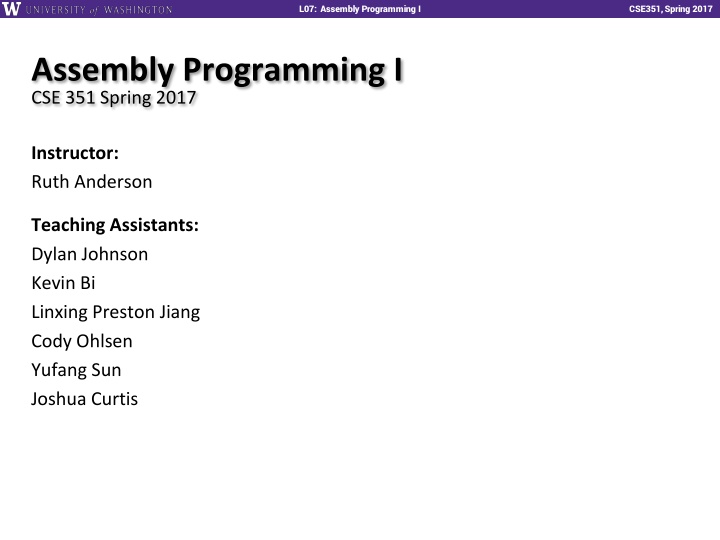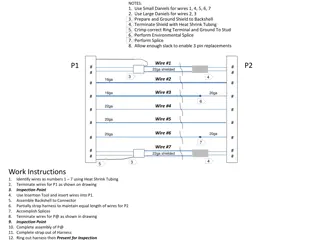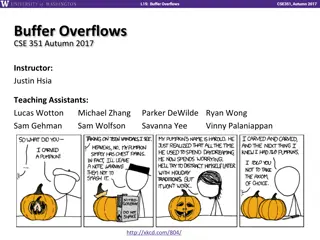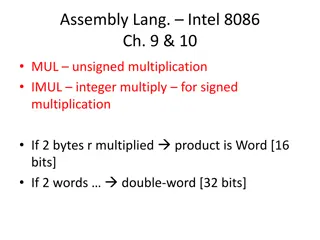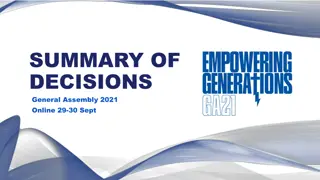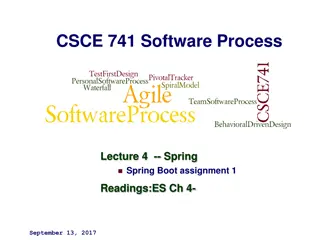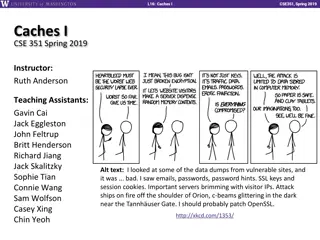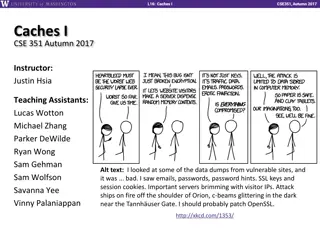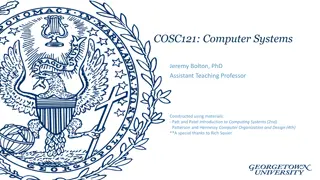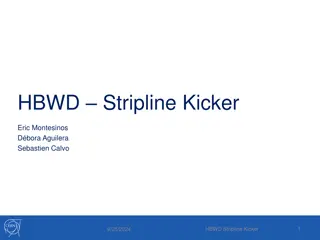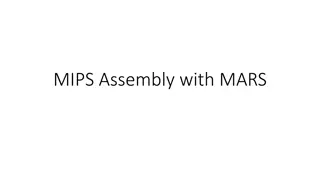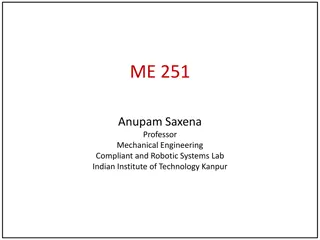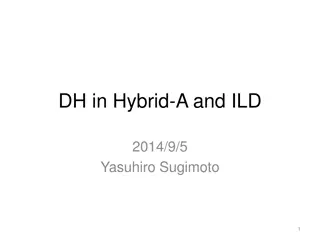Assembly Programming in CSE351 Spring 2017
Explore the world of assembly programming through CSE351 in Spring 2017. Delve into topics like memory, data, x86 assembly, procedures, executables, arrays, and more. Learn about the differences in Java and C, machine code, hardware, compilers, and the factors that influence program performance. Understand instruction set architectures and their impact on system state, CPU operations, memory, and registers.
Download Presentation

Please find below an Image/Link to download the presentation.
The content on the website is provided AS IS for your information and personal use only. It may not be sold, licensed, or shared on other websites without obtaining consent from the author.If you encounter any issues during the download, it is possible that the publisher has removed the file from their server.
You are allowed to download the files provided on this website for personal or commercial use, subject to the condition that they are used lawfully. All files are the property of their respective owners.
The content on the website is provided AS IS for your information and personal use only. It may not be sold, licensed, or shared on other websites without obtaining consent from the author.
E N D
Presentation Transcript
L07: Assembly Programming I CSE351, Spring 2017 Assembly Programming I CSE 351 Spring 2017 Instructor: Ruth Anderson Teaching Assistants: Dylan Johnson Kevin Bi Linxing Preston Jiang Cody Ohlsen Yufang Sun Joshua Curtis
L07: Assembly Programming I CSE351, Spring 2017 Administrivia Lab 1 due Friday (4/14) Prelim submission (3+ of bits.c) due on TONIGHT (4/10). Turn in whatever you have at that time (drop box closes at 11:59pm), no lates. Worth a small part (no more than 10%) of total points for lab 1. Homework 2 due next Wednesday (4/19) 2
L07: Assembly Programming I CSE351, Spring 2017 Roadmap Memory & data Integers & floats x86 assembly Procedures & stacks Executables Arrays & structs Memory & caches Processes Virtual memory Memory allocation Java vs. C C: Java: Car c = new Car(); c.setMiles(100); c.setGals(17); float mpg = c.getMPG(); car *c = malloc(sizeof(car)); c->miles = 100; c->gals = 17; float mpg = get_mpg(c); free(c); Assembly language: get_mpg: pushq %rbp movq %rsp, %rbp ... popq %rbp ret OS: Machine code: 0111010000011000 100011010000010000000010 1000100111000010 110000011111101000011111 Computer system: 3
L07: Assembly Programming I CSE351, Spring 2017 Translation Code Time Compile Time Run Time User program in C C Assembler Hardware compiler .c file .exe file What makes programs run fast(er)? 4
L07: Assembly Programming I CSE351, Spring 2017 HW Interface Affects Performance Hardware Architecture Instruction set Source code Different applications or algorithms Compiler Perform optimizations, generate instructions Different implementations Intel Pentium 4 C Language Intel Core 2 Program A x86-64 Intel Core i7 GCC AMD Opteron Program B AMD Athlon Clang Your program ARMv8 (AArch64/A64) ARM Cortex-A53 Apple A7 5
L07: Assembly Programming I CSE351, Spring 2017 Instruction Set Architectures The ISA defines: The system s state (e.g. registers, memory, program counter) The instructions the CPU can execute The effect that each of these instructions will have on the system state CPU PC Memory Registers 6
L07: Assembly Programming I CSE351, Spring 2017 Instruction Set Philosophies Complex Instruction Set Computing (CISC): Add more and more elaborate and specialized instructions as needed Lots of tools for programmers to use, but hardware must be able to handle all instructions x86-64 is CISC, but only a small subset of instructions encountered with Linux programs Reduced Instruction Set Computing (RISC): Keep instruction set small and regular Easier to build fast hardware Let software do the complicated operations by composing simpler ones 7
L07: Assembly Programming I CSE351, Spring 2017 General ISA Design Decisions Instructions What instructions are available? What do they do? How are they encoded? Registers How many registers are there? How wide are they? Memory How do you specify a memory location? 8
L07: Assembly Programming I CSE351, Spring 2017 General ISA Design Decisions Instructions What instructions are available? What do they do? How are they encoded? Instructions are data! Registers How many registers are there? How wide are they? Size of a word Memory How do you specify a memory location? Different ways to build up an address 9
L07: Assembly Programming I CSE351, Spring 2017 Mainstream ISAs Macbooks & PCs (Core i3, i5, i7, M) x86-64 Instruction Set Smartphone-like devices (iPhone, iPad, Raspberry Pi) ARM Instruction Set Digital home & networking equipment (Blu-ray, PlayStation 2) MIPS Instruction Set 10
L07: Assembly Programming I CSE351, Spring 2017 Definitions Architecture (ISA): The parts of a processor design that one needs to understand to write assembly code What is directly visible to software Microarchitecture: Implementation of the architecture CSE/EE 469, 470 Are the following part of the architecture? Number of registers? How about CPU frequency? Cache size? Memory size? 11
L07: Assembly Programming I CSE351, Spring 2017 Definitions Architecture (ISA): The parts of a processor design that one needs to understand to write assembly code What is directly visible to software Microarchitecture: Implementation of the architecture CSE/EE 469, 470 Are the following part of the architecture? Number of registers? Yes How about CPU frequency? No Cache size? Memory size? No 12
L07: Assembly Programming I CSE351, Spring 2017 Assembly Programmer s View CPU Memory Addresses Registers Code Data Stack PC Data Condition Codes Instructions Programmer-visible state PC: the Program Counter (%rip in x86-64) Address of next instruction Named registers Memory Byte-addressable array Code and user data Includes the Stack (for supporting procedures) Together in register file Heavily used program data Condition codes Store status information about most recent arithmetic operation Used for conditional branching 13
L07: Assembly Programming I CSE351, Spring 2017 x86-64 Assembly Data Types Integral data of 1, 2, 4, or 8 bytes Data values Addresses (untyped pointers) Floating point data of 4, 8, 10 or 2x8 or 4x4 or 8x2 Different registers for those (e.g.%xmm1, %ymm2) Come from extensions to x86 (SSE, AVX, ) Not covered In CSE 351 No aggregate types such as arrays or structures Just contiguously allocated bytes in memory Two common syntaxes AT&T : used by our course, slides, textbook, gnu tools, Intel : used by Intel documentation, Intel tools, Must know which you re reading 14
L07: Assembly Programming I CSE351, Spring 2017 What is a Register? A location in the CPU that stores a small amount of data, which can be accessed very quickly (once every clock cycle) Registers have names, not addresses In assembly, they start with % (e.g.%rsi) Registers are at the heart of assembly programming They are a precious commodity in all architectures, but especially x86 15
L07: Assembly Programming I CSE351, Spring 2017 x86-64 Integer Registers 64 bits wide %rax %rbx %rcx %rdx %rsi %rdi %r8 %r9 %r10 %r11 %r12 %r13 %r14 %r15 %eax %r8d %ebx %r9d %ecx %r10d %edx %r11d %esi %r12d %edi %r13d %rsp %rbp %esp %r14d %ebp %r15d Can reference low-order 4 bytes (also low-order 2 & 1 bytes) 16
L07: Assembly Programming I CSE351, Spring 2017 Some History: IA32 Registers 32 bits wide %eax %ax %ah %al accumulate %ecx %cx %ch %cl counter general purpose %edx %dx %dh %dl data %ebx %bx %bh %bl base %esi %si source index %edi %di destination index %esp %sp stack pointer %ebp %bp base pointer 16-bit virtual registers (backwards compatibility) Name Origin (mostly obsolete) 17
L07: Assembly Programming I CSE351, Spring 2017 Memory vs. Registers Addresses 0x7FFFD024C3DC vs. Names %rdi Big ~ 8 GiB vs. Small (16 x 8 B) = 128 B Slow ~50-100 ns vs. Fast sub-nanosecond timescale Dynamic Can grow as needed while program runs vs. Static fixed number in hardware 18
L07: Assembly Programming I CSE351, Spring 2017 Three Basic Kinds of Instructions 1)Transfer data between memory and register Load data from memory into register %reg = Mem[address] Store register data into memory Mem[address] = %reg Remember: Memory is indexed just like an array of bytes! 2)Perform arithmetic operation on register or memory data c = a + b; z = x << y; i = h & g; 3)Control flow: what instruction to execute next Unconditional jumps to/from procedures Conditional branches 19
L07: Assembly Programming I CSE351, Spring 2017 Operand types %rax %rcx %rdx %rbx %rsi %rdi %rsp %rbp Immediate: Constant integer data Examples: $0x400, $-533 Like C literal, but prefixed with $ Encoded with 1, 2, 4, or 8 bytes depending on the instruction Register: 1 of 16 integer registers Examples: %rax, %r13 But %rsp reserved for special use Others have special uses for particular instructions Memory: Consecutive bytes of memory at a computed address Simplest example: (%rax) Various other address modes %rN 20
L07: Assembly Programming I CSE351, Spring 2017 Moving Data General form: mov_ source, destination Missing letter (_) specifies size of operands Note that due to backwards-compatible support for 8086 programs (16-bit machines!), word means 16 bits = 2 bytes in x86 instruction names Lots of these in typical code movb src, dst Move 1-byte byte movl src, dst Move 4-byte long word movw src, dst Move 2-byte word movq src, dst Move 8-byte quad word 21
L07: Assembly Programming I CSE351, Spring 2017 movq Operand Combinations Source Dest Src, Dest C Analog movq $0x4, %rax var_a = 0x4; Reg Imm movq $-147, (%rax) *p_a = -147; Mem movq movq %rax, %rdx var_d = var_a; Reg Reg movq %rax, (%rdx) *p_d = var_a; Mem movq (%rax), %rdx var_d = *p_a; Mem Reg Cannot do memory-memory transfer with a single instruction How would you do it? 22
L07: Assembly Programming I CSE351, Spring 2017 Question Which of the following statements is TRUE? A. For float f, (f+2 == f+1+1) always returns TRUE B. The width of a word is part of a system s architecture (as opposed to microarchitecture) C. Having more registers increases the performance of the hardware, but decreases the performance of the software D. Mem to Mem (src to dst) is the only disallowed operand combination in x86-64 23
L07: Assembly Programming I CSE351, Spring 2017 Summary Converting between integral and floating point data types does change the bits Floating point rounding is a HUGE issue! Limited mantissa bits cause inaccurate representations Floating point arithmetic is NOT associative or distributive x86-64 is a complex instruction set computing (CISC) architecture Registers are named locations in the CPU for holding and manipulating data x86-64 uses 16 64-bit wide registers Assembly operands include immediates, registers, and data at specified memory locations 24
